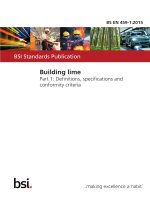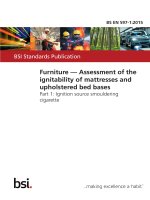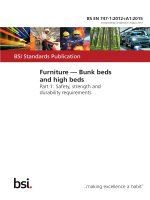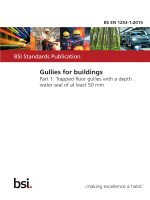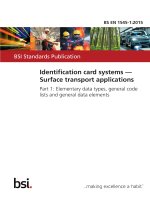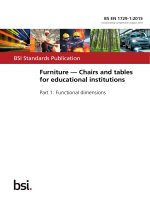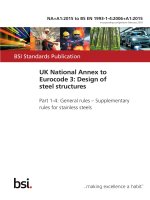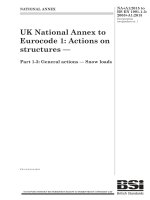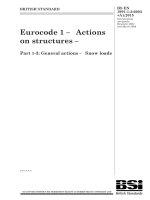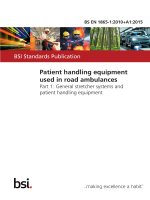Bsi bs en 61811 1 2015
Bạn đang xem bản rút gọn của tài liệu. Xem và tải ngay bản đầy đủ của tài liệu tại đây (1.62 MB, 58 trang )
BS EN 61811-1:2015
BSI Standards Publication
Electromechanical telecom
elementary relays of
assessed quality
Part 1: Generic specification and
blank detail specification
BRITISH STANDARD
BS EN 61811-1:2015
National foreword
This British Standard is the UK implementation of EN 61811-1:2015. It is
identical to IEC 61811-1:2015. It supersedes BS EN 61811-1:1999,
BS EN 61811-50:2002, BS EN 61811-51:2002, BS EN 61811-52:2002,
BS EN 61811-53:2002, BS EN 61811-54:2002, BS EN 61811-55:2002,
BS EN 61811-10:2003 and BS EN 61811-11:2003, which are withdrawn.
The UK participation in its preparation was entrusted to Technical
Committee EPL/94, General purpose relays and reed contact units.
A list of organizations represented on this committee can be obtained on
request to its secretary.
This publication does not purport to include all the necessary provisions of
a contract. Users are responsible for its correct application.
© The British Standards Institution 2015.
Published by BSI Standards Limited 2015
ISBN 978 0 580 82205 6
ICS 29.120.70
Compliance with a British Standard cannot confer immunity from
legal obligations.
This British Standard was published under the authority of the
Standards Policy and Strategy Committee on 30 April 2015.
Amendments/corrigenda issued since publication
Date
Text affected
BS EN 61811-1:2015
EUROPEAN STANDARD
EN 61811-1
NORME EUROPÉENNE
EUROPÄISCHE NORM
ICS 29.120.70
March 2015
Supersedes EN 61811-1:1999, EN 61811-10:2003, EN
61811-11:2003, EN 61811-50:2002, EN 61811-51:2002,
EN 61811-52:2002, EN 61811-53:2002, EN 6181154:2002, EN 61811-55:2002
English Version
Electromechanical telecom elementary relays of assessed
quality - Part 1: Generic specification and blank detail
specification
(IEC 61811-1:2015)
Relais télécom électromécaniques élémentaires soumis au
régime d'assurance qualité - Partie 1: Spécification
générique et spécification particulière cadre
(IEC 61811-1:2015)
Elektromechanische Telekom-Elementarrelais mit
bewerteter Qualität - Teil 1: Fachgrundspezifikation und
Bauartspezifikation
(IEC 61811-1:2015)
This European Standard was approved by CENELEC on 2015-03-04. CENELEC members are bound to comply with the CEN/CENELEC
Internal Regulations which stipulate the conditions for giving this European Standard the status of a national standard without any alteration.
Up-to-date lists and bibliographical references concerning such national standards may be obtained on application to the CEN-CENELEC
Management Centre or to any CENELEC member.
This European Standard exists in three official versions (English, French, German). A version in any other language made by translation
under the responsibility of a CENELEC member into its own language and notified to the CEN-CENELEC Management Centre has the
same status as the official versions.
CENELEC members are the national electrotechnical committees of Austria, Belgium, Bulgaria, Croatia, Cyprus, the Czech Republic,
Denmark, Estonia, Finland, Former Yugoslav Republic of Macedonia, France, Germany, Greece, Hungary, Iceland, Ireland, Italy, Latvia,
Lithuania, Luxembourg, Malta, the Netherlands, Norway, Poland, Portugal, Romania, Slovakia, Slovenia, Spain, Sweden, Switzerland,
Turkey and the United Kingdom.
European Committee for Electrotechnical Standardization
Comité Européen de Normalisation Electrotechnique
Europäisches Komitee für Elektrotechnische Normung
CEN-CENELEC Management Centre: Avenue Marnix 17, B-1000 Brussels
© 2015 CENELEC All rights of exploitation in any form and by any means reserved worldwide for CENELEC Members.
Ref. No. EN 61811-1:2015 E
BS EN 61811-1:2015
EN 61811-1:2015
-2-
Foreword
The text of document 94/379/FDIS, future edition 2 of IEC 61811-1, prepared by
IEC/TC 94 "All-ornothing electrical relays" was submitted to the IEC-CENELEC parallel vote and
approved by CENELEC as EN 61811-1:2015.
The following dates are fixed:
•
latest date by which the document has to be
implemented at national level by
publication of an identical national
standard or by endorsement
(dop)
2015-12-04
•
latest date by which the national
standards conflicting with the
document have to be withdrawn
(dow)
2018-03-04
This document supersedes EN 61811-1:1999, EN 61811-10:2003, EN 61811-11:2003,
EN 61811-50:2002, EN 61811-51:2002, EN 61811-52:2002, EN 61811-53:2002, EN 61811-54:2002
and EN 61811-55:2002.
Attention is drawn to the possibility that some of the elements of this document may be the subject of
patent rights. CENELEC [and/or CEN] shall not be held responsible for identifying any or all such
patent rights.
Endorsement notice
The text of the International Standard IEC 61811-1:2015 was approved by CENELEC as a European
Standard without any modification.
In the official version, for Bibliography, the following notes have to be added for the standards indicated:
IEC 60068-2-47:2005
NOTE
Harmonized as EN 60068-2-47:2005 (not modified).
IEC 61649
NOTE
Harmonized as EN 61649.
IEC 61709:2011
NOTE
Harmonized as EN 61709:2011 (not modified).
ISO 9001:2008
NOTE
Harmonized as EN ISO 9001:2008 (not modified).
BS EN 61811-1:2015
EN 61811-1:2015
-3-
Annex ZA
(normative)
Normative references to international publications
with their corresponding European publications
The following documents, in whole or in part, are normatively referenced in this document and are
indispensable for its application. For dated references, only the edition cited applies. For undated
references, the latest edition of the referenced document (including any amendments) applies.
NOTE 1 When an International Publication has been modified by common modifications, indicated by (mod), the relevant
EN/HD applies.
NOTE 2 Up-to-date information on the latest versions of the European Standards listed in this annex is available here:
www.cenelec.eu
Publication
Year
Title
EN/HD
Year
IEC 60062
2004
Marking codes for resistors
and capacitors
EN 60062
+ corr. January
2005
2007
IEC 60068-1
2013
Environmental testing Part 1: General and guidance
EN 60068-1
2014
IEC 60068-2-17
1994
Basic environmental testing procedures Part 2: Tests - Test Q: Sealing
EN 60068-2-17
1994
IEC 60068-2-20
2008
Environmental testing EN 60068-2-20
Part 2-20: Tests - Test T: Test methods
for solderability and resistance to soldering
heat of devices with leads
2008
IEC 60068-2-58
2004
Environmental testing EN 60068-2-58
Part 2-58: Tests - Test Td: Test methods + corr. December
for solderability, resistance to dissolution of
metallization and to soldering heat of
surface mounting devices (SMD)
2004
2004
IEC 60410
1973
Sampling plans and procedures for
inspection by attributes
-
IEC 60695-11-5
2004
Fire hazard testing EN 60695-11-5
Part 11-5: Test flames - Needle-flame test
method - Apparatus, confirmatory test
arrangement and guidance
2005
IEC 61810
Series
Electromechanical elementary relays
EN 61810
Series
Electromechanical elementary relays Part 1: General requirements
EN 61810-1
2008
1)
-
IEC 61810-1
2008
IEC 61810-2
2011
Electromechanical elementary relays Part 2: Reliability
EN 61810-2
2011
IEC 61810-7
2006
Electromechanical elementary relays EN 61810-7
Part 7: Test and measurement procedures
2006
ISO 2859
Series
Sampling procedures for inspection by
attributes
1)
Superseded by IEC 61810-1:2015.
-
BS EN 61811-1:2015
–2–
IEC 61811-1:2015 IEC 2015
CONTENTS
1
Scope .............................................................................................................................. 7
2
Normative references ...................................................................................................... 7
3
Terms and definitions ...................................................................................................... 8
3.1
Type of relays ......................................................................................................... 8
3.2
Types of contacts .................................................................................................... 8
3.3
Contact fault and contact failure .............................................................................. 9
3.4
Relay malfunction, relay failure ............................................................................... 9
3.5
Relay construction types ......................................................................................... 9
3.6
Inspection level and sample size ........................................................................... 10
4
Rated values ................................................................................................................. 10
4.1
General ................................................................................................................. 10
4.2
Rated coil voltages ............................................................................................... 10
4.3
Contact-circuit resistance ...................................................................................... 10
4.4
Dielectric test ........................................................................................................ 10
4.5
Impulse voltage test .............................................................................................. 10
4.6
Insulation resistance ............................................................................................. 11
4.7
Number of operations determining electrical endurance ........................................ 11
4.8
Contact failure rate for test evaluation purposes ................................................... 11
5
Marking and documentation ........................................................................................... 11
5.1
General ................................................................................................................. 11
5.2
Marking of the relay .............................................................................................. 11
5.3
Marking of the package ......................................................................................... 11
5.4
Coded date of manufacture ................................................................................... 11
6
Preparation of blank detail and detail specifications ....................................................... 11
7
Quality assessment procedures ..................................................................................... 13
7.1
Primary stage of manufacture ............................................................................... 13
7.2
Structurally similar relays ...................................................................................... 13
7.3
Qualification approval procedures ......................................................................... 13
7.4
Quality conformance inspection ............................................................................ 13
7.4.1
Grouping of tests ........................................................................................... 13
7.4.2
Resubmission of rejected lots ........................................................................ 14
7.4.3
Delivery of relays subjected to destructive tests or non-destructive tests ....... 14
7.4.4
Delayed delivery ............................................................................................ 14
7.4.5
Supplementary procedure for deliveries ......................................................... 15
7.4.6
Unchecked parameters .................................................................................. 15
7.4.7
Release for delivery before completion of group B tests ................................. 15
7.4.8
Screening procedures .................................................................................... 15
7.4.9
Formation of inspection lots ........................................................................... 15
7.4.10
Periodic inspection ........................................................................................ 15
7.5
Periodic inspection / Intervals between tests ......................................................... 15
8
Test schedule ................................................................................................................ 16
8.1
8.2
8.3
Test sequence ...................................................................................................... 16
Types of relays, based upon environmental protection (relay technology (RT))
............................................................................................................................. 16
Categories of application of contacts .................................................................... 16
BS EN 61811-1:2015
IEC 61811-1:2015 IEC 2015
–3–
8.4
Order of tests ........................................................................................................ 16
8.5
Test groups and subgroups ................................................................................... 16
9
Tests ............................................................................................................................. 21
9.1
Standard conditions for testing .............................................................................. 21
9.2
Mounting of test specimens during the test ........................................................... 21
9.3
General conditions for testing ............................................................................... 21
10 Ordering information ...................................................................................................... 21
Annex A (informative) Relay reliability – Failure rate data .................................................... 22
A.1
General ................................................................................................................. 22
A.2
Scope ................................................................................................................... 22
A.3
Description of the relay ......................................................................................... 22
A.3.1
Identification .................................................................................................. 22
A.3.2
Ratings .......................................................................................................... 22
A.4
Fault and failure data ............................................................................................ 23
A.4.1
Fault and failure definition ............................................................................. 23
A.4.2
Fault application ............................................................................................ 23
A.4.3
Failure definition ............................................................................................ 23
A.4.4
Failure application ......................................................................................... 23
A.5
Source of data ...................................................................................................... 23
A.6
Weibull approach .................................................................................................. 23
A.7
WeiBayes approach .............................................................................................. 24
A.7.1
Description .................................................................................................... 24
A.7.2
Method .......................................................................................................... 24
A.7.3
WeiBayes without failures .............................................................................. 24
A.7.4
WeiBayes with failures ................................................................................... 24
A.7.5
WeiBayes case study ..................................................................................... 25
Annex B (informative) Characteristic values of the relay ...................................................... 27
B.1
General data ......................................................................................................... 27
B.2
Coil data ............................................................................................................... 28
B.3
Contact data ......................................................................................................... 28
B.3.1
Electrical endurance and switching frequency ................................................ 28
B.3.2
Static contact-circuit resistance ..................................................................... 28
B.3.3
Mechanical endurance ................................................................................... 28
B.3.4
Timing (without suppression device) .............................................................. 29
B.4
Mounting ............................................................................................................... 29
B.5
Environmental data ............................................................................................... 29
B.6
Package of relays for automatic handling (if applicable) ........................................ 29
Annex C (informative) Blank detail and detail specification .................................................. 30
C.1
Examples for front pages ...................................................................................... 30
C.1.1
General ......................................................................................................... 30
C.1.2
Type 0 – Non-standardized types and construction ........................................ 30
C.1.3
Type 1 – Two change-over contacts, 20 mm × 10 mm base ........................... 31
C.1.4
Type 2 – Two change-over contacts, 14 mm × 9 mm base ............................. 32
C.1.5
Type 3 – Two change-over contacts, 15 mm × 7,5 mm base .......................... 33
C.1.6
Type 4 – Two change-over contacts, 11 mm × 7,5 mm (max.) base ............... 34
C.1.7
Key to front page ........................................................................................... 35
C.2
Qualification approval procedures ......................................................................... 35
C.3
Quality conformance inspection ............................................................................ 35
BS EN 61811-1:2015
–4–
IEC 61811-1:2015 IEC 2015
C.4
Formation of inspection lots .................................................................................. 36
Annex D (informative) Definition of subgroups ..................................................................... 53
Bibliography .......................................................................................................................... 54
Figure A.1 – New compressor design WeiBayes versus old design ....................................... 26
Table 1 – Group A ................................................................................................................ 17
Table 2 – Group B ................................................................................................................ 18
Table 3 – Group C ................................................................................................................ 19
Table B.1 – Dielectric test voltages ....................................................................................... 27
Table B.2 – Impulse test voltages ......................................................................................... 27
Table B.3 – Coil data ............................................................................................................ 28
Table B.4 – Loads, contact-circuit resistance limits, switching cycles and frequencies
for electrical endurance and overload tests ........................................................................... 28
Table C.1 – Quality conformance inspection ......................................................................... 36
Table C.2 – Qualification approval ........................................................................................ 50
Table C.3 – Industrial qualification ........................................................................................ 52
BS EN 61811-1:2015
IEC 61811-1:2015 IEC 2015
–7–
ELECTROMECHANICAL TELECOM ELEMENTARY
RELAYS OF ASSESSED QUALITY –
Part 1: Generic specification and blank detail specification
1
Scope
This part of IEC 61811 applies to electromechanical telecom elementary relays. Relays
according to this standard are provided for the operation in telecommunication applications.
However, as electromechanical elementary relays, they are also suitable for particular
industrial and other applications.
This standard selects from IEC 61810 series and other sources the appropriate methods of test to
be used in detail specifications derived from this specification, and contains basic test
schedules to be used in the preparation of such specifications in accordance with this standard.
Detailed test schedules are contained in the detail specifications.
2
Normative references
The following documents, in whole or in part, are normatively referenced in this document and
are indispensable for its application. For dated references, only the edition cited applies. For
undated references, the latest edition of the referenced document (including any
amendments) applies.
IEC 60062:2004, Marking codes for resistors and capacitors
IEC 60068-1:2013, Environmental testing – Part 1: General and guidance
IEC 60068-2-17:1994, Basic environmental testing procedures – Part 2-17: Tests – Test Q:
Sealing
IEC 60068-2-20:2008, Environmental testing – Part 2-20: Tests – Test T: Test methods for
solderability and resistance to soldering heat of devices with leads
IEC 60068-2-58:2004, Environmental testing – Part 2-58: Tests – Test Td: Test methods for
solderability, resistance to dissolution of metallization and to soldering heat of surface
mounting devices (SMD)
IEC 60410:1973, Sampling plans and procedures for inspection by attributes
IEC 60695-11-5:2004, Fire hazard testing – Test flames – Needle-flame test method –
Apparatus, confirmatory test arrangement and guidance
IEC 61810 (all parts), Electromechanical elementary relays
IEC 61810-1:2008, Electromechanical elementary relays – Part 1: General requirements
IEC 61810-2:2011, Electromechanical elementary relays – Part 2: Reliability
IEC 61810-7:2006, Electromechanical elementary relays – Part 7: Test and measurement
procedures
BS EN 61811-1:2015
–8–
IEC 61811-1:2015 IEC 2015
ISO 2859 (all parts), Sampling procedures for inspection by attributes
3
Terms and definitions
For the purposes of this document, the terms and definitions given in IEC 61810 series, as
well as the following apply.
3.1
Type of relays
The most frequent types of electromechanical telecom elementary relays are defined in 3.1.1,
3.1.2, 3.1.3 and 3.1.4.
3.1.1
bistable relay
electrical relay which, having responded to an energizing quantity and having changed its
condition, remains in that condition after the quantity has been removed; a further appropriate
energization is required to make it change its condition.
[SOURCE:IEC 60050-444:2002, 444-01-08]
3.1.2
monostable relay
electrical relay which, having responded to an energizing quantity and having changed its
condition, returns to its previous condition when that quantity is removed
[SOURCE: IEC 60050-444:2002, 444-01-07]
3.1.3
non-polarized relay
electrical relay, the change of condition of which does not depend upon the polarity of its
energizing quantity
[SOURCE: IEC 60050-444:2002, 444-01-10]
3.1.4
polarized relay
polarized elementary relay
electrical relay, the change of condition of which depends upon the polarity of its d.c.
energizing quantity
[SOURCE: IEC 60050-444:2002, 444-01-09; modified – In the definition, "elementary relay"
has been replaced by "electrical relay".]
3.2
Types of contacts
3.2.1
change-over break-before-make contact
change-over contact, one contact circuit of which breaks before the other makes
[SOURCE: IEC 60050-444:2002,444-04-21, modified – The definition has been reworded.]
3.2.2
change-over make-before-break contact
change-over contact, one contact circuit of which makes before the other breaks
[SOURCE: IEC 60050-444:2002, 444-04-20, modified – The definition has been reworded.]
BS EN 61811-1:2015
IEC 61811-1:2015 IEC 2015
3.3
–9–
Contact fault and contact failure
3.3.1
failure to make
failure caused when no sufficient contact is ensured
Note 1 to entry: This could be a not acceptable or excessive contact resistance exceeds the maximum value
stated in the detail specification as well a bouncing of the contact due to the lost of overtravel.
3.3.2
failure to break
failure caused when the current flows although it should not
Note 1 to entry: For example, This could be a contact welding/sticking as well as a delayed contact operate or
release contact. Also, it is assumed that the contact does not open, when the resistance of an open contact
assembly falls below the specified minimum value stated in the detail specification
3.3.3
malfunction
single event when an item does not perform a required function
3.3.4
contact failure
occurrence of break and/or make malfunctions of a contact under test, exceeding a specified
number
3.4
Relay malfunction, relay failure
3.4.1
relay malfunction
the state of a relay characterized by the inability to perform a required function
Note 1 to entry: A fault persists for a limited time after which the relay recovers the ability to perform a required
function without being subjected to any corrective maintenance.
3.4.2
failure
termination of the ability of an item to perform a required function
[SOURCE:IEC 60050-191:1990, 191-04-01]
3.5
Relay construction types
3.5.1
type 0
non-standardized types and construction
3.5.2
type 1
two change-over contacts, 20 mm × 10 mm base
3.5.3
type 2
two change-over contacts, 14 mm × 9 mm base
3.5.4
type 3
two change-over contacts, 15 mm × 7,5 mm base
BS EN 61811-1:2015
– 10 –
IEC 61811-1:2015 IEC 2015
3.5.5
type 4
two change-over contacts, 11 mm × 7,5 mm (max.) base
3.6
Inspection level and sample size
3.6.1
IL
Special Inspection Level in accordance to the ISO 2859 series
3.6.2
AQL
Acceptance Quality Limit in accordance to the ISO 2859 series
3.6.3
Lot-by-lot
Period: inspection lot refers to the production volume of not more than one week
4
4.1
Rated values
General
The following subclauses contain preferred values applicable to electromechanical telecom
elementary relays.
4.2
Rated coil voltages
Preferred values d.c.: 1,5 V; 3 V; 4,5 V; 5 V; 6 V; 9 V; 12 V; 24 V; 48 V or 60 V.
4.3
Contact-circuit resistance
a) Preferred values in initial condition: maximum 50 mΩ; 100 mΩ or 200 mΩ.
b) Preferred values during/after tests: maximum 0,5 Ω; 1 Ω; 5 Ω; 10 Ω; 20 Ω or 100 Ω.
c) Preferred value for detecting faults due to non-opening of the contact circuit during tests:
minimum 100 kΩ.
d) Voltage for detecting faults due to non-opening of the contact circuit during tests;
preferred maximum values: 0,03 V; 5 V; 6 V; 12 V; 24 V; 48 V or 60 V d.c.
e) Difference of contact-circuit resistance between different contact circuits in the same relay,
preferred value: maximum 100 mΩ (initial condition).
4.4
Dielectric test
Preferred values in initial condition between opened contact circuits, between separate
contact circuits, between contact circuits and coil(s), between all conductive parts and mass
(if applicable) in accordance with IEC 61810-1.
a) Preferred voltages: 0,5 kV; 0,8 kV; 1,5 kV; 2,5 kV a.c.
b) Preferred duration: 1 s or 60 s
4.5
Impulse voltage test
a) Preferred voltages: 0,5 kV; 1,0 kV; 1,5 kV; 2 kV or 2,5 kV.
b) Preferred waveform: 0,5 µs/700 µs, 1,2 µs/50 µs or 10 µs/700 µs.
c) Preferred number of pulses (alternate positive and negative pulses): 10.
d) Preferred frequency of pulses: 2 pulses/min or 4 pulses/min.
BS EN 61811-1:2015
IEC 61811-1:2015 IEC 2015
4.6
– 11 –
Insulation resistance
Preferred value: 1 000 MΩ at 500 V d.c. initial value.
4.7
Number of operations determining electrical endurance
Preferred values: 10 000; 20 000; 50 000; 100 000; 200 000; 500 000; 700 000; 1 000 000;
1 600 000; 2 000 000; 5 000 000; 10 000 000; 20 000 000 or 30 000 000.
4.8
Contact failure rate for test evaluation purposes
Preferred values: maximum 10 –5 , 10 –6 , 10 –7 , 10 –8 /contact/cycle.
5
5.1
Marking and documentation
General
Relays and their package supplied in accordance with detail specifications covered by this
sectional specification shall be marked as follows:
5.2
Marking of the relay
a) Manufacturer's name, logo or trade mark.
b) Relay type and variant code.
c) Coded date of manufacture, in terms of year/week according to 5.4.
5.3
Marking of the package
a) Manufacturer's name, logo or trade mark.
b) Relay type and variant code.
c) Manufacturer's batch identification code.
d) Detail specification reference if not marked on the relay.
e) Quantity.
5.4
Coded date of manufacture
The marking system shall use four figures as specified in 6.2 of IEC 60062:2004. The first two
figures shall be the last two figures of the year and the last two figures the numbering of the
week.
EXAMPLE
Fifth week of 1994 = 9405.
If stated in the detail specification only, the first two figures shall be the last two figures of the
year, the month is represented by the next two figures and the day of the month is
represented by the last two figures.
EXAMPLE
6
20th June 1994 = 940620.
Preparation of blank detail and detail specifications
Blank detail specifications shall conform to the test schedules given in Table 1 of this
specification and the related explanations.
The blank specification as given in Annex C shall be used for the preparation and
characteristic values of the relay shall be included as given in Annex B. The values shall be
adjusted by the manufacturer as appropriate.
BS EN 61811-1:2015
– 12 –
IEC 61811-1:2015 IEC 2015
Blank detail specifications shall give the following information or call for its inclusion in the
detail specification:
a) Identification of the detail specification.
b) Identification of the relay and information on its applications; identification shall be
provided by such properties as size, sealing, whether monostable or bistable, polarized or
not, or other characteristics required for identification, contact operating range and
temperature range.
c) Outline drawing of the relay and key dimensions; variants, such as for terminals, may be
given in an annex to the detail specification.
Customer packaging requirements for automatic handling.
d) Reference data of the relay.
1) A limited number of values is required on the front page to describe the overall
performance of the relay.
2) Full information in conformance with Clause 4 and IEC 61810-1 shall be added on one
of the subsequent pages. Rated values preferably should be those listed therein.
Where tests refer to rated values, this shall be indicated with each test. Where tests
are to be performed at other than rated values, the test values shall be indicated and
clearly distinguished from the rated values.
e) Normative references.
Reference shall be made to IEC 61810 series. When reference to further documents is
necessary, such documents shall be listed with their full titles, year of edition and, unless
common knowledge, the source from which they can be obtained.
f)
Assessment level.
Table 1 of this specification contains one test schedule. If additional tests not listed there
have been added, this shall be stated.
g) Periodicity of tests.
h) Formation of inspection lots, if predictable in the sense of 7.4.9 and 8.1.
i)
Order of tests, if deviating from 8.4.
j)
General test conditions, if deviating from 4.5 of IEC 61810-7:2006.
k) Qualification approval test schedule.
l)
Quality conformance test schedule.
For each group of tests, the final measurements and post-test requirements specified in
each of them may be summarized and stated at the end of the subgroup.
It shall be stated that samples subjected to destructive tests (D) shall not be released for
delivery.
If application of SPC or ppm approach is required, this should be provided the
manufacturer.
m) Specification of IL numbers (groups A and B) and sample sizes (group C).
n) Specification of AQL numbers (groups A and B) and acceptable numbers of defectives
(group C).
o) Marking of package and/or relays beyond those listed in this specification, if necessary.
p) Ordering information
Additional information such as curves and drawings may be given in an annex to the detail
specification. Such information is not required to be verified for test purposes.
When preparing blank detail or detail specifications, the following procedures should be
followed:
–
select the tests to be performed from Table 1 of this sectional specification;
BS EN 61811-1:2015
IEC 61811-1:2015 IEC 2015
–
– 13 –
if necessary, add any other necessary tests, required or not specified in IEC 61810-7.
Examples for front pages of detail specifications are given in Annex C.
7
Quality assessment procedures
7.1
Primary stage of manufacture
The primary stage of manufacture is the first process subsequent to the manufacture of
finished parts and subassemblies of the relay.
NOTE
A subassembly is understood to mean here the permanent assembly of two or more piece parts.
Important manufacturing steps are as follows:
a) fabrication, heat treatment and plating of the component parts of the relay;
b) coil winding;
c) assembling of the electrical and electromechanical parts;
d) adjustment of the relay contacts, if applicable;
e) high-temperature drying, gas backfilling and sealing of the relay, if applicable;
f)
final measurements and periodic inspection of test groups A to C.
7.2
Structurally similar relays
Relays are considered structurally similar if they have no differences in design other than:
a) wire diameter and of windings;
b) types, numbers and material of contacts;
c) rated coil and/or contact voltage(s);
d) mounting and terminal variants within the limits prescribed in the data sheet or
specification.
e) biasing of the input circuit parts.
7.3
Qualification approval procedures
Qualification approval tests shall include all the tests prescribed in the detail specification and
shall be performed by a schedule specifically prescribed in the detail specification.
The number of specimens for each subgroup is specified in the blank detail specification. As a
general rule, a minimum of five specimens are required for each group of tests.
7.4
Quality conformance inspection
7.4.1
7.4.1.1
Grouping of tests
General
The purpose of grouping tests is to combine in one group all those tests which are of equal
importance to the assessment of the usefulness of the relay. Therefore, each test in the same
subgroup gets the same inspection level and acceptable quality level range, and therefore
further criteria for the allocation of tests to a group are the destructiveness of the test, the
duration of the test and the relation to the fabrication or design.
The frequency of testing takes account of the complexity, duration and overall cost of the test,
and the effect of releasing non-conforming relays.
BS EN 61811-1:2015
– 14 –
IEC 61811-1:2015 IEC 2015
Characteristics tested at the same frequency and having similar importance to the function of
the relay are combined into the same subgroup.
7.4.1.2
Division into groups (see Annex D)
Lot-by-lot tests are divided into two groups.
a) Group A, covering the visual and dimensional inspection of the relays and non-destructive
short-duration electrical and mechanical test procedures which are employed to assess
the principal characteristics of the relays determined mainly by the fabrication process, as
those which are of a design nature and of vital importance.
b) Group B, covering both destructive and non-destructive test procedures, with a duration of
up to about one week, which are employed to assess the characteristics of the relays
determined mainly by the fabrication process, as those which are of a design nature and
of vital or major importance.
The periodic tests are generally brought together and designated group C tests. Tests in this
group comprise both destructive and non-destructive test procedures that are applied
periodically to confirm that certain characteristics, in addition to those already included in
groups A and B, are being maintained. These characteristics may be related either to design
or to the fabrication process and can be of vital, major and minor importance to the function of
the relay.
If appropriate, a group D may be included containing additional tests required for the
maintenance of qualification approval.
7.4.1.3
Division into subgroups
Groups can be further subdivided into subgroups (see Annex D). Division is made according
to the relative importance (vital, major, minor) of the feature to the overall function of the relay
and the frequency of testing; thus the subgroup to which the test should be allocated is
determined.
The sectional and/or blank detail specification shall show the order in which the tests or
conditions in the subgroup shall be carried out where this order may affect the test results.
The blank detail specification shall also indicate wherever any particular order of testing in
any subgroup is to be observed. Where a subgroup contains a destructive test, this shall
either be stated in full or the symbol "D" shall be placed alongside the title of the subgroup in
the schedule of inspection requirements in the blank detail specification.
7.4.2
Resubmission of rejected lots
No requirements at present.
7.4.3
Delivery of relays subjected to destructive tests or non-destructive tests
Relays subjected to destructive tests shall not be included in the lot for delivery. Relays
subjected to non-destructive tests may be delivered provided they are re-tested to group A
requirements and satisfy them.
7.4.4
Delayed delivery
Relays which have been held by the manufacturer for a period exceeding 12 months following
acceptance inspection, shall be re-inspected as prescribed in the detail specification, unless a
different period is specified therein.
If this has been done for the complete lot, no further retesting before delivery is needed for
another period of one year or as otherwise specified in the detail specification.
BS EN 61811-1:2015
IEC 61811-1:2015 IEC 2015
7.4.5
– 15 –
Supplementary procedure for deliveries
When this has been nationally recognized, manufacturers may, at their discretion, supply
relays that have met a higher assessment level against orders for a lower assessment level.
7.4.6
Unchecked parameters
When supplementary information is given in detail specifications, this shall not be the subject
of inspection.
7.4.7
Release for delivery before completion of group B tests
When the conditions of IEC 60410 for reduced inspection have been satisfied for all group B
tests, the manufacturer is permitted to release the relays before the completion of such tests.
7.4.8
Screening procedures
When screening is specified in the detail specification or the purchase order, it is to be
applied to all devices in the production lot prior to the formation of samples for quality
conformance testing (lot-by-lot and periodic).
The test shall be performed in the given order. When, however, part of the screening
sequence is already performed during production and in the same sequence, it need not be
repeated.
Any device found defective during any of the tests shall be removed and not considered as
part of the production lot for subsequent sampling purposes.
When the number of defectives at the end of the screening exceeds 10 % of the size of the
production lot, this lot shall be rejected for the intended application of the appropriate test
schedule. If not contradictory, the lot may be used for a lower specified application.
7.4.9
Formation of inspection lots
Inspection lots submitted to groups A and B acceptance tests shall be formed in accordance
with 8.5 and with the sampling plans and procedures given in IEC 60410, except where
production is too infrequent or too small for sampling plans to apply; in these cases inspection
shall be 100 %.
When sampling is carried out in accordance with IEC 60410, the percent defective concept
only shall be used. Stratified or representative sampling shall always be used to include all
production lines and structurally similar relays in proportion to their respective quantities in
the lot. Exceptions from proportionality may become necessary and shall be stated in the
detail specification. Specimens shall be as representative as possible of the production.
The determination basis for the sample sizes from continuous production lines shall be stated
in the blank detail specification.
7.4.10
Periodic inspection
Fixed sample sizes for group C inspection shall be taken from a lot (or lots) which has (have)
passed groups A and B inspection during or at the end of the specified reference period.
7.5
Periodic inspection / Intervals between tests
–
Subgroups A4, B1 and B2:
minimum once a week.
–
Subgroups C1 and C2:
at least once a year.
–
Subgroups C4 to C6:
at least once every two years.
BS EN 61811-1:2015
– 16 –
8
IEC 61811-1:2015 IEC 2015
Test schedule
8.1
Test sequence
The order of tests in each subgroup of Table 1, and in the derived schedule in any
corresponding blank detail specification, is mandatory unless a specific statement to the
contrary is given. The sealing test shall always be the final test.
8.2
Types of relays, based upon environmental protection (relay technology (RT))
RT 0
unenclosed relay
RT I
dust-protected relay
RT II
flux-proof relay
RT III wash-tight relay
RT IV sealed relay
RT V
hermetically sealed relay
The definitions of protection and sealing are defined in 5.9 of IEC 61810-1:2008.
8.3
Categories of application of contacts
CC 0
30 mV max./10 mA max.
CC 1
A load without arcing (no arc duration longer than 1 ms)
CC 2
A high load where contact arcing can occur.
The definitions of contact application are defined in Annex C of IEC 61810-1:2008.
The actual power rating of the contacts at minimum and maximum loads and the required
number of switched cycles shall be defined in the detail specification (see 8.5).
8.4
Order of tests
Quality conformance inspection is divided into two parts: that carried out lot-by-lot, on which
the release of the individual lots is based, and that carried out on a periodic basis, which
contains the time-consuming and more expensive tests.
When several tests are subsequently to be carried out on any one specimen or number of
specimens, the following order shall apply, unless otherwise prescribed in the detail
specification:
a) a 100 % test with a screening or sorting function shall always precede any other nondestructive (ND) or destructive (D) test;
b) tests in groups other than a 100 % test shall be performed in the sequence given in the
blank detail specification. It shall be ensured that the effects of earlier tests are not
liable to invalidate the results of the later tests.
8.5
Test groups and subgroups
For the 100 % test subgroup, a relay shall be rejected when it fails any test. For detection
purposes, a contact can be considered closed when the voltage drop across it is less than
one half of its open-circuit value. Conditions of test shall be specified in the detail
specification. All contact loads shall be at a level that does not cause significant change to the
contact surfaces.
Electrical endurance testing shall be for a minimum number of operations as defined in the
blank detail or detail specification. If required, these tests can be continued to failure in order
to acquire reliability data. Failure criteria and rules shall be specified in the blank detail
specification.
BS EN 61811-1:2015
IEC 61811-1:2015 IEC 2015
– 17 –
For electromechanical telecom elementary relays, the majority contact action is break-beforemake change-over. To ensure that the contact sequencing occurs in this order, the transfer
time measurement refers to the time interval during which all contact circuits of a relay are
open.
Analogously, to ensure that the make-before-break change-over contact sequencing occurs in
the right order, the bridging time measurement refers to the time interval during which all
contact circuits of a relay are closed.
Specifying of time to stable closing in the detail specification is optional.
Abbreviations:
M:
mandatory test to be included in the blank detail or detail specification;
R:
recommended test to be included in the blank detail or detail specification;
(D):
destructive test;
(ND):
non-destructive test.
Details are given in the following Table 1 to Table 3.
Table 1 – Group A
Subgroup A0
For all tests in this subgroup: 100 % test. The lot shall be rejected in case of failure rate of
more than % cumulative. All tests carried out at ambient 23 °C.
Test from IEC 61810-7:2006
Subclause
Options and particular requirements
Visual inspection – relay marking (ND)
4.6.2 a) and 4.6.2 b)
R
Coil resistance (ND)
4.8.1
M
Dielectric test (ND)
4.9
M
Contact-circuit resistance, static (ND)
4.12
M
Test voltage and current as for
CC 0
Functional tests (ND)
4.13
M
Checking the relay function by
monitoring the contacts
Timing tests (ND)
4.14.2
M
Sealing (ND)
4.20.2
R
Procedure 1 (test Qc, method 2),
procedure 2
(test Qk, method
1 or 2) or procedure 4
(test Qy) for RT III and RT IV
Acoustic noise (ND)
4.44
R
If stated in the detail specification
only
BS EN 61811-1:2015
– 18 –
IEC 61811-1:2015 IEC 2015
Subgroup A4
For all tests in this subgroup
IL:
AQL:
S-4
0,25...1,0...4
Lot-by-lot
Test from IEC 61810-7:2006
Subclause
Options and particular requirements
Visual inspection – relay marking (ND)
4.6.2, items a) and b)
M
Coil resistance (ND)
4.8.1
M
Contact-circuit resistance, static (ND)
4.12
M
Test voltage and current as for CC 0
Functional tests (ND)
4.13
M
Checking the relay function by monitoring
the contacts
Timing tests (ND)
4.14.2
M
Sealing (ND)
4.20.2
M
Procedure 1 (test Qc, method 2), procedure 2
(test Qk, method 1 or 2) or procedure 4
(test Qy) for RT III and RT IV
Acoustic noise (ND)
4.44
R
If stated in detail specification
only
Table 2 – Group B
Subgroup B1
For all tests in this subgroup
IL:
S-3
AQL:
0,4...1,0...4
Lot-by-lot
Test from IEC 61810-7:2006
Subclause
Options and particular requirements
Visual inspection – check of dimensions of
stick magazines (ND)
4.6.1 and 4.6.2 a)
M
Visual inspection – other than marking, check of
relay outside key dimensions (ND)
4.6.1 and 4.6.2 c) and 4.6.2 d)
M
If applicable
Subgroup B2
For all tests in this subgroup
IL:
S-3
AQL:
0,4...1,0...4
Lot-by-lot
Test from IEC 61810-7:2006
Subclause
Solderability (D)
4.25
Options and particular requirements
M
If not tested in sub-group C1
BS EN 61811-1:2015
IEC 61811-1:2015 IEC 2015
– 19 –
Table 3 – Group C (1 of 2)
Subgroup C1
For all tests in this subgroup fixed sample size.
Period shall not exceed 1 year.
Test from IEC 61810-7:2006
Subclause
Options and particular requirements
Magnetic interference (ND)
4.37
R
If stated in the detail specification only
Solderability (D)
4.25
M
For relays manufactured with automatic
facilities only, if not tested in subgroup B2
Electrical endurance (D)
4.30
M
Severity level A , definition of contact fault and
contact failure in accordance with 3.3 of this specification
Subgroup C2
For all tests in this subgroup fixed sample size.
Period shall not exceed 1 year.
Test from IEC 61810-7:2006
Subclause
Options and particular requirements
Acoustic noise (ND)
4.44
R
Dielectric test (ND)
4.9
M
Impulse voltage test (ND)
4.10
M
Insulation resistance (ND)
4.11
M
Sealing (ND)
4.20.2
R
Method 1, only if not tested in A0 or A4
respectively
Procedure 1 (test Qc, method 2), procedure 2
(test Qk, method 1 or 2) or procedure 4
(test Qy) for RT III and RT IV
Subgroup C4
For all tests in this subgroup fixed sample size in accordance with A.4 of IEC 61810-2:2011.
Period shall not exceed 2 years.
Test from IEC 61810-7:2006
Subclause
Electrical endurance, extended assessment (D)
4.30
Options and particular requirements
M
Severity level A; prolongation of test from subgroup
C1 possible,
definition of contact fault and contact failure in
accordance with 3.3 of this specification
BS EN 61811-1:2015
– 20 –
IEC 61811-1:2015 IEC 2015
Table 3 – Group C (2 of 2)
Subgroup C5
For all tests in this subgroup fixed sample size.
Period shall not exceed 2 years.
Test from IEC 61810-7:2006
Subclause
Options and particular requirements
Climatic sequence (D)
4.15
M
Dry heat, 4.15.2
Damp heat cyclic, 4.15.3
Cold, 4.15.4
Damp heat cyclic, 4.15.6
Damp heat, steady state (D)
4.16
M
Robustness of terminals (D)
4.24
M
Shock (D)
4.26
M
Method 1, functional
Method 2, survival
Vibration (D)
4.28
M
Method 1, functional
Mechanical endurance (D)
4.31
M
Method 2
Thermal endurance (D)
4.32
M
Overload (contact circuit) (D)
4.34
M
Magnetic interference (ND)
4.37
R
Resistance to cleaning solvents (D)
4.47.2
M
Fire hazard (D)
4.48.2
M
Only if not tested in C1
Procedure according to IEC 60695-11-5:2004
Subgroup C6
For all tests in this subgroup fixed sample size.
Period shall not exceed 2 years.
Test from IEC 61810-7:2006
Subclause
Options and particular requirements
Weighing (ND)
4.7.2
M
Thermal resistance (ND)
4.17
M
Rapid change of temperature (D)
4.19
M
Method 1
Resistance to soldering heat (D)
4.25.2
M
Method 2 for THR
Methode 4 for SMD
BS EN 61811-1:2015
IEC 61811-1:2015 IEC 2015
9
9.1
– 21 –
Tests
Standard conditions for testing
If not otherwise stated, all tests shall be performed under standard conditions for testing
according to 4.5 of IEC 61810-7:2006.
9.2
Mounting of test specimens during the test
The following indications shall apply for mechanical-dynamic tests (shock and vibration): the
relay shall be mounted by its normal mounting method to the test fixture where inherent
resonances have been minimized so as not to invalidate the test (see also IEC 60068-2-47).
9.3
General conditions for testing
Unless otherwise stated, the rated coil voltage specified in Table B.3 and its suitable polarity
(if applicable) shall be used for all tests and its application to the relay.
10 Ordering information
The manufacturer shall provide a complete and unambiguous coding for all relays covered by
the detail specification, containing all relevant characteristics as e.g. rated coil voltage,
contact configuration, mounting type or any special attributes as applicable.
The coding of the monostable or bistable relay type shall be combined with the rated power of
the coil, if applicable.
The reference to the number and types of contacts shall be given on the front page of the
specification.
A conversion list with the manufacturer's part numbers may be given in an annex to the detail
specification.
BS EN 61811-1:2015
– 22 –
IEC 61811-1:2015 IEC 2015
Annex A
(informative)
Relay reliability – Failure rate data
A.1
General
The evaluation and indication of reliability data is not mandatory.
However, if required in a detail specification (see Annex C), the failure rate data for the
reliability prediction of telecom relays in electronic equipment (telecommunication systems,
data processing, etc.) shall be stated in an appropriate way. It is strongly recommended to
give such data in accordance with IEC 61709. Therefore, the preferred (blank) data base for
failure rates, the stress model and the particular stress factors for conversion of the failure
rate data at reference conditions to the actual operating conditions are given in this
informative annex. In the relevant detail specification, reference shall be made to this annex
and further details shall be given.
The reference failure rate shall be determined by the manufacturer for his particular relay type.
The relay manufacturer is required to log cumulatively all endurance test data and all other
relevant data including those derived from field experience, which would demonstrate/
indicate achieved reliability. The endurance tests specified in the detail specification are
intended, amongst other things, to provide a measure of the failure rate under prescribed
conditions.
If another stress model, or other stress factors respectively, are known to be more suitable for
a particular relay type, such deviations shall be clearly described in an annex of the relevant
detail specification and used instead (all necessary details which allow the conversion of the
failure rate data to the actual operating conditions and the source(s) of these data shall be
described).
Relay manufacturers are not required to demonstrate the achievement of the failure rate data
before delivery of a specific lot.
A.2
Scope
This annex details the data base for failure rates of telecom relays based on IEC 61810-2 and
IEC 61649. If required in the relevant detail specification, the information given below and any
further details necessary should be given in a respective annex in that specification.
A.3
A.3.1
Description of the relay
Identification
The XY relay in accordance to the detail specification. For further details, see boxes (5) and
(6) of the relevant detail specification (see Annex C).
A.3.2
Ratings
Coil data and contact data see boxes (9), (10) and (11) of the relevant detail specification
(see Annex C).
BS EN 61811-1:2015
IEC 61811-1:2015 IEC 2015
A.4
A.4.1
– 23 –
Fault and failure data
Fault and failure definition
According to 3.4 of this specification – see also IEC 61810-2.
A.4.2
Fault application
Useful life time period. Beginning of useful life time: relay in new condition; end of useful life
time: number of switching cycles stated in Table B.4 of the relevant blank detail specification.
A.4.3
Failure definition
Contact failure: contact-circuit resistance of a closed contact higher than 1 Ω, or resistance of
an open contact circuit lower than 100 kΩ, both more than once per 10 5 cycles (or for the
minimum number of switching cycles stated), calculated for each single contact; or a contact
fault due to non-opening with a short circuit between break and make contact (resistance
value lower than 100 Ω). This means that one contact fault is permissible for 100 000
switching cycles and seven contact faults are permissible for 700 000 switching cycles.
A.4.4
Failure application
Wear-out failure time period .
A.5
Source of data
Manufacturer’s laboratory tests in accordance with IEC 61810-2.
A.6
Weibull approach
The Weibull analysis in accordance to IEC 61810-2 shall be used, if there are no historical
data are available. Otherwise, the WeiBayes approach in accordance to IEC 61649 could be
used.
The main data out of Weibull are:
a) Mean cycles to failure (MCTF)
The point 63,2 % estimate of the mean cycles to failure is m.
b) Value of B10
The point estimate of B 10 , in number of cycles by which 10 % of the population will have failed.
c) Mean time to failure (MTTF)
Only where an estimate of the number of cycles per unit of time appropriate to a specific end
use is known, then a mean time to failure (MTTF) for the relay can be determined.
EXAMPLE If the number of cycles per unit of time is equal to 100 cycles per day and the
relay MCTF value is 3 185 × 10 3 , the MTTF for the relay in this application can be calculated
as follows:
MTTF = MCTF / Number of cycles per unit of time = 3 185 × 10 3 / 100 = 31 850 days.
